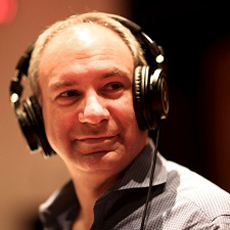If you want to know the recipe for good music, don’t ask Michael Giacchino. He only knows about GREAT music! As Remy the rat in Pixar’s Ratatouille shows, every great meal starts with great ingredients. And Michael knows just how to select and warm up great musicians, and gain them to his cause. Just by providing exciting parts, filled with energy, passion, emotion… and a great sense of swing!
That’s where we reach the unexpected in his score for the Oscar-winning Ratatouille. No Frenchy muzak in here. Just an incredible melting-pot of different influences – different tastes – inspired by the film’s storytellers. So, meet again “chef Giacchino” who, after having “lifted” us up to the sky, put our eyes down to the plate for one of the tastiest scores ever, rewarded by a Grammy Award and an Academy Award nomination for best score!
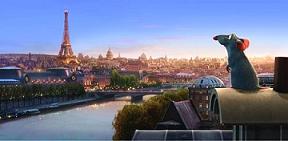
Animated Views: You were in Paris for the World Premiere of Ratatouille. What was it like, to be in Remy’s city?
 Michael Giacchino: Being in Paris was fantastic! I had the greatest time. It was the best place to see that movie. So, I took my whole family, we all went. Being there and seeing it with my kids in French, with my kids was the best moment. It was really nice being in a theater in Paris watching it all in French, no subtitles, just the way it should be, you know. It was a great experience. And also, working with the French singer Camille [pictured with Michael, right] on Le Festin, the title song, was a great experience, too. She was just wonderful. I don’t know if you know how I came to find her. It’s a very strange story…
Michael Giacchino: Being in Paris was fantastic! I had the greatest time. It was the best place to see that movie. So, I took my whole family, we all went. Being there and seeing it with my kids in French, with my kids was the best moment. It was really nice being in a theater in Paris watching it all in French, no subtitles, just the way it should be, you know. It was a great experience. And also, working with the French singer Camille [pictured with Michael, right] on Le Festin, the title song, was a great experience, too. She was just wonderful. I don’t know if you know how I came to find her. It’s a very strange story…
AV: Please, can you tell me?
MG: I just found her on the internet simply by googling “female French vocalist”. I just typed these words and hundreds and hundreds of people came up. I just started going through listening to things and I came across her website and I just absolutely loved her voice and the songs that she had written. She seemed like a great creative person. So we called her asking : “hey, do you want to sing the song for the movie?”. That was completely out of the blue like that!
AV: How did you work with her?
MG: We had a great time working together. She’s a great person to work with, very creative, very serious about what she does, but also somewhat goofy, too, which is really nice.
AV: Did she have any input in the creation of the song?
MG: You know, when I went to the recording session, we kind of had the framework for the song. But of course, she had great ideas in certain ways of singing things. She was very good at just coming up with really great little ideas for the way certain sentences could be phrased. And we worked together to make those harmonies happen, too, which was really fun. We did have a framework for the harmonies in the background. That was something we just did there while we were recording the song.
AV: Where did you record it?
MG: We recorded in Vancouver, actually.
AV: She also did the French voice of Colette.
MG: Yes, she did. After she sang the song, they really liked her voice and they temped her for the role of Colette and she got it.
AV: Brad Bird’s films like The Incredibles are not very much song-oriented. How did you come to put a song in Ratatouille?
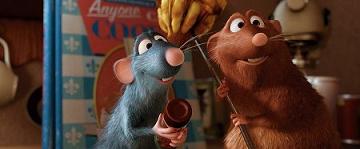 MG: It was interesting. At first, they had wanted some sort of old-fashioned kind of typical French-sounding song for this one section of the film and I really felt that we should do something different, something special to what the movie is. Because the movie itself was so different, so special. I wanted the song not to be something that was cliché of what we consider French. I wanted it to just be a good song that hopefully could last for years, because the film would be on for ever. I just wanted to do something that was right for the film, and the song really comes out of the main theme of the film.
MG: It was interesting. At first, they had wanted some sort of old-fashioned kind of typical French-sounding song for this one section of the film and I really felt that we should do something different, something special to what the movie is. Because the movie itself was so different, so special. I wanted the song not to be something that was cliché of what we consider French. I wanted it to just be a good song that hopefully could last for years, because the film would be on for ever. I just wanted to do something that was right for the film, and the song really comes out of the main theme of the film.
That theme was written very early on. It was the first thing I wrote for the movie. So, when it came time to do the song, I was trying all these different things and then I thought: “why am I trying all these different things? Why not just use the main theme and turn that into the melody for the song?”. And it ended up work quite nicely, I think. It was Brad’s idea to have it there in the middle of the film and then he wanted it for just the very end. He said: “why don’t we start the song earlier and finish it as a recap?” And it was just about us kind of working it out together exactly how it was gonna fit in. But Brad always did want a song that kind of identify the movie.
AV: Since the film was initiated first by Jan Pinkava and then taken over by Brad Bird, at what stage of the production did you come on board?
MG: When I came on board, Jan was still there on the film. He’s a wonderfully talented guy, one of the nicest people I’ve ever met. But I really wasn’t there when he decided to kind of leave Pixar. For me, my relationship was mainly always with Brad. Because I think that first it was Marc Shaiman who was intended to do it. But things kind of change as they do on these projects from time to time. And there was nothing against Marc either because he’s amazing. It was just a circumstance thing. So, I accepted to be part of Ratatouille because Brad asked me. He’s one of my best friends, you know and I had a great time working with him on The Incredibles.
AV: Every subject Brad Bird touches becomes one-of-a-kind. Is it the same in your working relationship?
 MG: That’s how he operates. He doesn’t want to do something unless it’s going to be original and different and tells what might be a familiar story in a different way. It’s the same in matter of music. He does allow me to kind of mess around and come up with my own ideas. It’s not the kind of thing where he’s so forceful about what he thinks he needs. He has his basic ideas, what he wants and really leaves the construction of it up to me, which is really nice. Then we can work together. What I really enjoy is my time on the scoring stage with him because we can work together, we can listen to it and say: “wouldn’t it be better if we did this?” and then we change it right there on the spot. That’s always a really fun thing to do. Working with him, he really has a way of getting everyone’s creative best out of them. He has a good way of kind of energizing his group, which is really amazing because, you know, he asks nothing less of himself as well. It’s the same thing.
MG: That’s how he operates. He doesn’t want to do something unless it’s going to be original and different and tells what might be a familiar story in a different way. It’s the same in matter of music. He does allow me to kind of mess around and come up with my own ideas. It’s not the kind of thing where he’s so forceful about what he thinks he needs. He has his basic ideas, what he wants and really leaves the construction of it up to me, which is really nice. Then we can work together. What I really enjoy is my time on the scoring stage with him because we can work together, we can listen to it and say: “wouldn’t it be better if we did this?” and then we change it right there on the spot. That’s always a really fun thing to do. Working with him, he really has a way of getting everyone’s creative best out of them. He has a good way of kind of energizing his group, which is really amazing because, you know, he asks nothing less of himself as well. It’s the same thing.
AV: Was there any temp score to guide you when you came on board?
MG: Not really. It was really a rough thing because they were working so fast. By the time that Brad came on, they had to do the whole thing in a year and a half: they re-wrote the script, re-boarded the film, etc. It was a mad dash. So, basically, there were pieces of music just for himself so that he could have something there but they were not indicative of what he wanted for the film because he kept saying he didn’t know what the film should sound like. And neither did I when I first came on because it was such a different movie. And the film ended up being kind of a mix of a lot different things and yet, somehow, it seems to all work together. It’s kind of like jazz in a way. I think it’s very à propos in the way it turned out because jazz is in many ways just like cooking, when you’re just kind of throwing in different things and seeing what works. It’s all about that experimentation and the film’s score was very much like that. Which made it both extremely hard and extremely fun at the same time.

AV: When we think about the subject of the film – a rat who wants to become a chef in Paris – we don’t imagine the diversity of styles you put in your score, from jazz to South American music and to Gershwin, all these amazing ideas that work so well together, just like an unexpected and delicious recipe. How did you come to that?
MG: You know, I don’t know. A lot of it was guessing and hoping and just taking my best shot. In looking at Paris, Brad and I talked of how we felt the people. Traditionally, when they think about Paris, they think of accordion and of very specific cliché things. But the truth is that it’s made up of so many different kinds of elements. That means so many different people, so many different kinds of music. You know, there’s a big jazz movement there, there’s a big orchestral movement there, there’s a small kind of “café sound” there. It’s all there. I believe that everything that’s in the movie was drawn out of the city itself. It would have been very easy to just kind of look at a film like that and go: “oh, there should be nothing but accordion and jazz violin and jazz guitar, and then it’ll be good”. The film goes much deeper than that, as Brad wrote a script that is about the characters. When you kind of throw that into the mix, it guides what you need to do.
AV: The film is also about “good taste”. How do you put that concept in music?
MG: You know, there’s nothing wrong with an accordion. Accordion is a fantastic instrument. It’s just about, I think, how you use it and when you use it. So, you’re right, the film is guided by good taste, so it was one of those things that we had to be on to look at.
AV: Speaking of accordion, legendary accordionist Frank Marrocco (Doctor Zhivago, Schindler’s List, Toy Story 2, Pirates of the Caribbean, etc) did a fantastic job for that score!
MG: He’s incredible! Frank Marrocco can play anything on his instrument. Even in the song, I mean. We tried different sounds, from harmonica to standard accordion sound, and then he was there and he said: “what about this sound?”. And he had this accordion and he came up with this sound that was kind of neither, you know. It almost sounds like a clarinet but it’s not, it sounds a little like an accordion but it’s not. He just gave us that wonderful sound that kind of placed it no so much in France but just in the world.
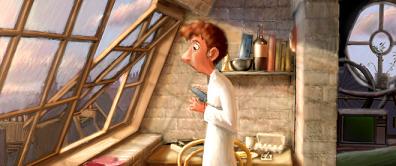
AV: Now, I’d like discuss specific scenes with you and talk about what you imagined for them. First of all, there is the beginning of the film, which takes place in a peaceful place in the French countryside, but with a very special granny…!
MG: Well, you think of French countryside as peaceful and serene, but in many ways, I always tried to just follow what Remy was doing. And what he was doing most of the time was thinking about cooking, thinking about food, thinking about the things that he loves to do. So, most of the time, my music was in that frame of mind. And I really did want, when the grandmother came, to be 100% different. Suddenly, it was big, orchestral action that you wouldn’t really expect from a grandmother. In the same way as when she pulls that shotgun. You’re not expecting that, you know. So, the music just goes a bit over the top there, and even more over the top after the rats come out of the ceiling and run to evacuate the house. In that, it’s about as frenetic and crazy as the film gets, I think. And when she puts the mask on, she’s like a villain and it was about hitting this huge, villainesque kind of ominous chord for that very moment.
AV: Surprisingly enough, there is no music then, when Remy is going down the rapids in the fewer. Can you explain why?
MG: We actually wrote a cue for that, but very early on, even before we recorded it, we knew we weren’t gonna use it. But we recorded it anyway. It was just one of those things like “well, let’s record it to have it”. But we were looking for spots not to have music and I think that was the perfect example of a place where you needn’t to heighten the drama or the fear of what was happening by adding music because that was already there. There is a point sometimes where you can over-dramatize a scene and risk pulling your audience out of it, and I think that was one of those things there that worked better without the music. Because then, after the scene, when he’s there all alone by himself and the music does come in, it means something more. You haven’t been hit over the head with “fear, fear, fear”, and then by “loneliness, loneliness, loneliness”, you know what I mean? It’s just about letting the action speak for itself and then underlining the idea that this guy is completely alone now.
AV: To me, one of the most beautiful cues of your score is Wall Rat, when Remy is climbing the walls, to get to the rooftops of Paris.
MG: It’s an interesting scene because, musically, it starts out very small: the string quartet and the flute as he’s moving through the house and between the walls, all of that, and as he gets closer and closer to the top, it starts filling up with more and more instrumentation. What I always try to do is to comment what’s happening in the picture somehow but in a way which is almost musically invisible. It’s almost as if you took a piece of music, put it up against a picture and it just happens to fit. A piece of music that was written away from the picture that just happens to fit so that it could work on its own or work with the picture. But really I try not to hit it over the head too much, because if you get too “Mickey Mousey” with it, it feels awkward and disjointed. So the challenge is: how do you do this and still make it feel like a natural piece of music. That’s one of the things I always enjoy sitting down trying to do. And then, finally, in the outside, the reveal of the city is what he’s been dreaming of all his life and that’s when you get that first big statement of his theme up there.
AV: This scene is also interesting in that it associated Remy’s two themes, one for the climbing and one of the discovering of Paris.
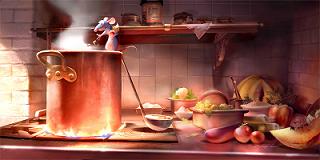 MG: Exactly. One represents who Remy is and the other represents who Remy wants to be. There the very “ratty” theme that’s his reality and then there’s the more wistful theme which is his hopes and dreams.
MG: Exactly. One represents who Remy is and the other represents who Remy wants to be. There the very “ratty” theme that’s his reality and then there’s the more wistful theme which is his hopes and dreams.
AV: Strangely enough, you didn’t use Remy’s dream theme when he’s cooking the soup for the first time.
MG: Well, I used that because here he was trapped in this kitchen and even though it would take him a second to kind of escape a little bit of that, he’s still in that kitchen and anyone could see him any second. So, it was about him using his rat theme in more of a kind of a distracted way like there’s the rat theme and then he’s distracted by the idea of fixing this soup. But he’s still kind of in danger. So, it was just about kind of suddenly using that in a really fun, joyful way, and then get back to where we were. Because I felt that it wasn’t a true moment of self-realization yet. It’s almost kind of an accident that he ran by that thing and he’s still in the middle of escaping. I wanted to try and save that other theme for the very true emotional moments and this one wasn’t one for me. It was more of a fun kind of sidebar, like I said, a distraction. He’s still a rat in a kitchen at that point. It was still too early in the story to really make that a more emotional moment.
AV: Let’s go now to Linguini’s theme that is played by a whistler during the scene when Remy and Linguini are practicing cooking together.
MG: There’s a guy in my orchestra. The name is Bobby Shulgold. He also plays the flute on all of that stuff, and he’s an amazing whistler. I had used him on Alias for a whistling piece and I always wanted to do it again, I always was hoping something would come up which would make sense to use him and that was the perfect thing. Brad wanted kind of a sort of a cowboy-ish poky feel to the music on that one, kind of like breaking your horse in, which is what Remy was doing with Linguini. So, that’s kind of how that came about.
AV: As for Colette, there are two different parts to her theme. Can you explain why?
 MG: The main part of that theme, which also shows out at the beginning of the end credits, is very confident. It’s almost like a tango-ish thing and in tango, you know that the dancers are always extremely confident, extremely sure of themselves. That’s who she is on the outside. In the kitchen, that’s who she has to be. But then there is a part of her that is a little more romantic, a little bit more unsure, and that’s the inside of her. She’s a very complicated character. She needs to be strong on the outside but the truth is that she is not that person in the inside.
MG: The main part of that theme, which also shows out at the beginning of the end credits, is very confident. It’s almost like a tango-ish thing and in tango, you know that the dancers are always extremely confident, extremely sure of themselves. That’s who she is on the outside. In the kitchen, that’s who she has to be. But then there is a part of her that is a little more romantic, a little bit more unsure, and that’s the inside of her. She’s a very complicated character. She needs to be strong on the outside but the truth is that she is not that person in the inside.
AV: Anyone Can Cook, that comes at the end of the movie, as Ego is reading his critic, is a very emotional moment, all the more unusual for the ending of a movie like this.
MG: Actually, that whole cue at the end of the movie was one of the first things I wrote. After I saw the movie for the first time, I went home and that’s what I wrote. Not to picture. I just wrote that theme. I think that that scene inspired that theme to come about. For me, that is the moment in the movie when everything is wrapping up, everything comes together and it tells exactly what this movie is. Everything else came out of that. And Ego is the one who kind of puts forward the message. It’s a very emotional scene. When you get through that whole movie and you get to that point, it is very emotional. And it’s very strange to be watching a movie about a rat who wants to cook and get emotional about it. That’s why the movie works. Because Brad writes “characters”. He doesn’t write “caricatures”.
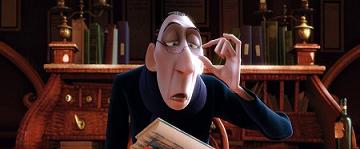
AV: The Endcreditouilles reminded me of the Incredits in The Incredibles.
MG: Yes, it was done with the same spirit. As you know, Brad loves to have big end pieces of music just like a kind of an overture, to celebrate the film. So, it was about taking all of the main characters’ themes, going crazy with them and being very improvisational with them adding in a lot of room for the players to solo, to put their own stamp on these themes. The idea behind that is very much like going a little nuts in the kitchen cooking something, trying from this and from that and seeing what works. It was about that idea of being free to do what you want to do. Jazz is to me the best way to express that idea, being free to go your own way. That’s what these Endcreditouilles were about.
AV: What is so fun about your score is that when we listen to the soundtrack, it’s like the story was told again through music.
 MG: I always to write the music so that it is tailor-made for a specific moment in the story, you know. There are very specific reasons why each cue is structured the way it is. It’s not just saying: “ok, this is an action scene so I need an action cue”. It’s about knowing what’s going on within the story of that action piece. So I do try to tailor my music really specifically to each individual scene. That’s the way it was for me when I was growing up listening to films scores. It was about re-living the story of the film. So, maybe it’s why I’m so adamant about it, but I enjoyed that as a kid; I loved listening to these score and re-living those stories. It was the only way you could do it when there were no DVDs or videos. If you weren’t in a theater watching the movie, the only chance you had to re-live it was to listen to the music and re-envision it in your head.
MG: I always to write the music so that it is tailor-made for a specific moment in the story, you know. There are very specific reasons why each cue is structured the way it is. It’s not just saying: “ok, this is an action scene so I need an action cue”. It’s about knowing what’s going on within the story of that action piece. So I do try to tailor my music really specifically to each individual scene. That’s the way it was for me when I was growing up listening to films scores. It was about re-living the story of the film. So, maybe it’s why I’m so adamant about it, but I enjoyed that as a kid; I loved listening to these score and re-living those stories. It was the only way you could do it when there were no DVDs or videos. If you weren’t in a theater watching the movie, the only chance you had to re-live it was to listen to the music and re-envision it in your head.
AV: Did you record the orchestra all live and all together at the same time, just like you did for The Incredibles?
MG: Yes. You know, I’m not against synthesizers. I think they can be used in a very creative way. Jerry Goldsmith was the master of that. He knew how to use them without trying to use them as something that they weren’t. But Ratatouille just didn’t have a real need for that. This one was about really things, real people and therefore, for me, it was all about real instrumentation, which is, you know, something I feel strongly about on most projects I do.
Recording voices separately, that’s not something I enjoy doing, because I feel that you’re not getting the full performance of the orchestra. That is almost the same as just using synthesizers: you’re not getting that energy that happens when players are in the room together. You have the string section playing against the brass section or the wind section playing against the string section or the percussion or whatever. They’re all together and they create a whole energy that you can only get if you have all the players at the same time.
If you layer on each section, you don’t get this energy and you’re also not getting the true sound of an orchestra. This sound is created because they’re all in that room together, messing with the air. That’s what creates that sound. And when you listen to scores that were recorded the other way, that’s not the true sound of an orchestra. I grew up listening to the true sound of it and that’s what I like! For me personally, I wouldn’t wanna do it any other way. You know, one of the greatest things on this project was to be able to work with these guys, all these incredible musicians. These players are just amazing. So, for me, as I’m writing it, I’m thinking in my head: “I can’t wait to hear them play it!”, because I know what these guys can do and how they sound.
AV: You also composed the music for the Ratatouille videogame. It’s very unusual to have the same composer doing both the film and the videogame. How’s that?
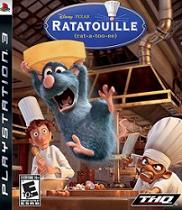 MG: You know, when they do these projects and they throw them out there, they sound nothing like the film does. It’s maybe because I come from videogames, but I try to just stay involved as much as can in the videogames that are produced about the projects that I’m working on. That way, there is a carry-over, they feel like they’re from the same family.
MG: You know, when they do these projects and they throw them out there, they sound nothing like the film does. It’s maybe because I come from videogames, but I try to just stay involved as much as can in the videogames that are produced about the projects that I’m working on. That way, there is a carry-over, they feel like they’re from the same family.
AV: In the videogame, we can pick out actual themes from the film, which is really rare.
MG: Yes, and that’s something I had to fight for because they had to pay for the use of those themes because Disney owns them. But I think it makes a huge difference. If a kid is gonna buy that game, he’s gonna want to kind of re-live the movie some way. So, the score is a huge part of it. It would like playing a Star Wars game and not having any Star Wars music in it. It doesn’t make sense, you know. So, on the first Incredibles videogame, they asked me to compose an original theme in the same vein as the one of the movie, but on the second one, Rise of the Underminer, I just put my foot down and said: “I’m not doing this unless we do it this way!”. That’s what I learned. You just have to be firm. The result is that it’s really nice to retrieve the themes of the movies in the games. And for the recording, we had different recording session, but with the same players. In fact, I did the music for the game before the second session for the film. Because we broke the sessions: we did some in November ’06 and some in April ’07, and the music for the game was done in the middle.
AV: In brief, what does Ratatouille represent to you?
MG: This film more than any other was truly a joy to see come to life, because it was the kind of music where the players were able to put a lot of their personality into it as well. So, that was really nice!

is available to buy now from Amazon.com
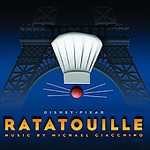
Our special appreciation and admiration to Michael for this interview and his superb score!
Images ©Disney/Pixar



